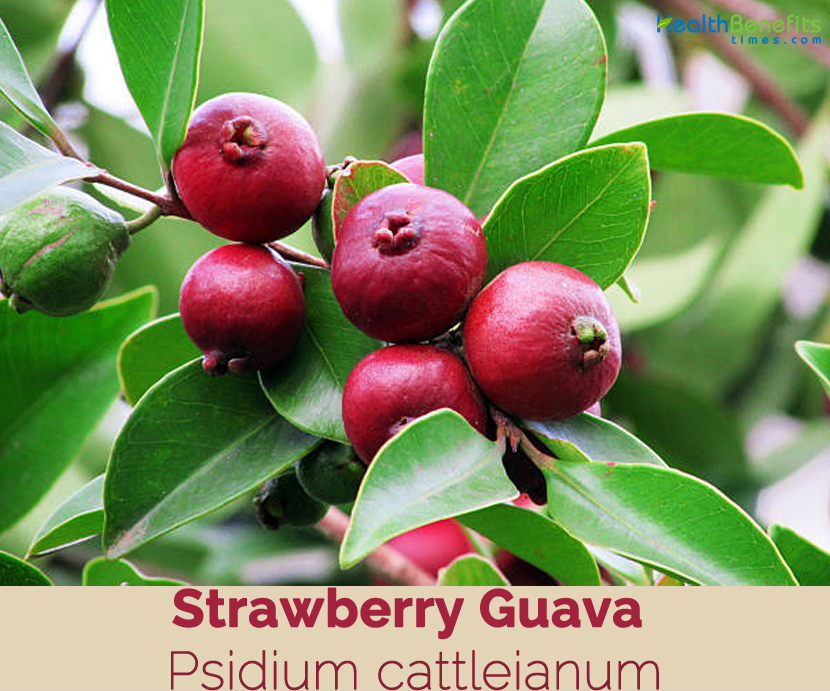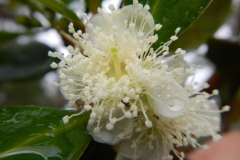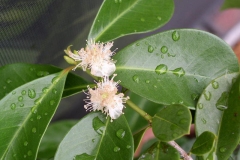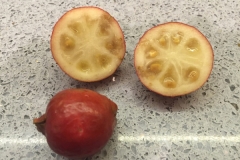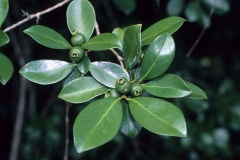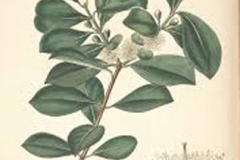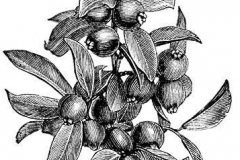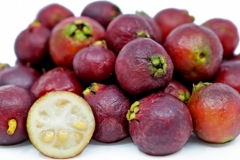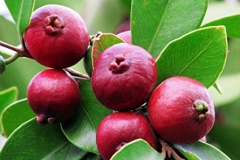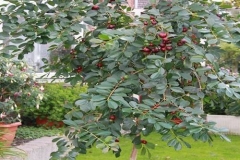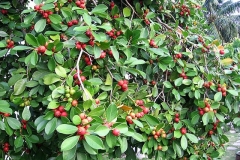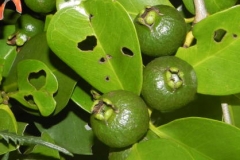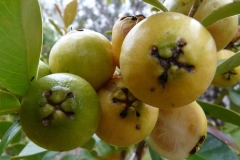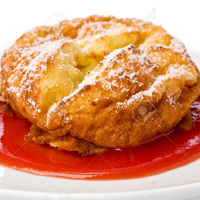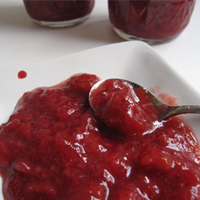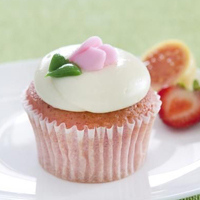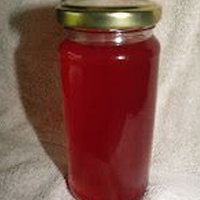The strawberry guava fruit is very similar to the normal guava (scientific name P. guava) but usually considered to be more attractive but smaller in size. Some of the popular common names of the plant are Cattley guava, Chinese cherry guava, Chinese guava, cherry guava, purple guava, purple strawberry guava, red strawberry guava, small guava, strawberry guava, yellow Cattley guava, yellow strawberry guava, Peruvian guava, Thai Guava, Kuahpa, Bella seebai, Konda jamipandu, Malam perakka, Mpera-ngombe, Mpera, Pahadi pijuli, Pahari payara, Porpay, Quwawa ni vavalagi and Seemai koyya. Strawberry guavas are delicious when consumed fresh, with an attractive sour taste caused by the very high content of vitamin C. Cherry guava can also be prepared in many ways, into jelly, jam, ice cream, sorbet or juice. Boiling the fruit in water with added sugar produces a paste that is useful in bakery products as a filling.
Plant Description
Strawberry Cherry is small erect, highly-branched, slow growing evergreen shrub that grows about 2-6 m tall. The plant is normally found growing in sub-montane rainforest, montane cloud forest, montane rainforest, moist tropical montane forest, riparian forest, tropical evergreen forest, deciduous woodland (oak), tropical montane savanna, lowland sub-tropical rainforest, scrubland, grassland, degraded forest, cultivation and agroforestry systems, roadsides, wastelands, pastures, scrubs, forested land and on areas disturbed by natural processes such as storms and lava flows. The plant prefers acid soils and is not sensitive to soil structure. It can grow on shallow or infertile soils. It does, however, requires a well-drained soil and does not tolerate waterlogging. The slender stem and branches are smooth, pinkish, greenish or greyish brown in color. Bark peels off in small papery flakes. Twigs are glabrous and cylindrical, and young leaves and twigs are red in color.
Leaves
Leaves are opposite and decussate, shortly petiolate (petiole 3–10 mm long), elliptic to obovate, 4.5–12 cm long and 2–6 cm wide, with a blunt to slightly acuminate apex and a cuneiform sharp base. They are thick and coriaceous, upper surface is dark green in color, glossy, waxy, flat or slightly folded around the main rib. The lower surface is glabrous, whitish-green in color, punctuated with small oil cavities, and with the main rib prominent near the base but the 8–10 pairs of lateral ribs is not prominent, forming an intra-marginal rib 1–3 mm from the edge of the limb. Young leaves and twigs are red in color.
Flower
The fragrant flowers are axillary and solitary, rarely grouped in 2 or 3. The four to five white petals are obovate, 5–6 mm long and wide. Flowers bear numerous stamens, 256 to 480 according to Raseira and Raseira, and a greenish disc-shaped stigma. Ovary is tri- to penta-locular, mostly tetra-locular. Flowering normally takes place from May.
Fruit
Fertile flowers are followed by globulous to obovoid berry, 1.5–4 cm in diameter, bearing persistent sepals at the apex. The thin skin is dark green when unripe, and then red to purple for P. cattleianum var. cattleianum and sulfur-yellow for P. cattleianum var. lucidum. Pulp is soft, white or yellow, very juicy and contains several (2–100) small soft seeds. Seeds are reniform, 2–3 mm long, with a yellowish testa. Fruit has a pleasant, strawberry-like flavor when ripe, hence its common name.
Health benefits of Strawberry Guava
Straw berry guava is quite nutritious fruit. Professionals say that the nutritional profile of strawberry guava is comparable to that of guava, though it claims double the calcium content of guava! Needless to say, the consistent consumption of strawberry guava can help in keeping your pearly whites strong. It can also help strengthen your bones and significantly lower your osteoporosis risk. Listed below are few of the most impressive health benefits of consuming strawberry guava
1. Stronger Immune System
As we all know that strawberry is rich in vitamin C content, it helps to make the immune system more effective at keeping the body safeguarded from disease-causing microbes. Addition of strawberry guava in the diet is especially beneficial when the season for various respiratory tract infections like the cold and flu is nearing.
2. Regular Bowel Movement
Since strawberry guava is loaded with fiber, consuming it on a regular basis helps flush out toxins and waste products in the gut. It’s the perfect addition to the everyday diet of anyone who is regularly bugged by constipation.
3. Healthy and Beautiful Skin
Just like guava, strawberry guava is also a remarkable source of vitamin C. It can help promote the healing of wounds and synthesis of collagen, which helps make the skin elastic and free of lines and wrinkles.
4. Controlled Blood Sugar
As mentioned previously strawberry guava fruits are full of fiber and help in weight loss as well as maintain normal blood pressure. These properties help in making it great for treating diabetes. Fiber in this fruit extracts the consumption of sugar and decreases the risk of your body suffering from high levels of glucose or insulin.
5. Stronger Gums
Other than the calcium it packs, strawberry guava also helps keep a person’s smile complete due to its loads of vitamin C, which is a nutrient so important for keeping the gums healthy and strong, and avoiding scurvy from striking.
6. Lower Blood Pressure
Apart from warding off constipation and spikes in blood sugar, the fact that strawberry guava is rich in fiber makes the fruit very good at keeping both cholesterol and blood pressure within the normal range. Thus frequent consumption of strawberry guava helps to lower a person’s risk of having deadly heart disease.
7. Stimulates digestion
These fruits are rich sources of dietary fiber and Vitamin C. Presence of dietary fiber in strawberries helps in improving digestion and enables proper movement of food through the small intestine. You can try having strawberries instead of the usual dessert you have. This is delightful and also helps in proper digestion.
8. Treats dysentery
Due to the presence of Vitamin C and fiber, strawberry guava is considered wonderful for your stomach. Astringent properties of this fruit can control microbial growth and help in getting rid of excess mucus form the intestine. In this way it helps in curing dysentery.
9. Improves eyesight
Vitamin A is present in high amounts in strawberry guavas. This makes it very beneficial for your eyes. Deficiency in Vitamin A can cause night blindness and poor vision. Consuming this fruit regularly can help in improving your eyesight as well as your health. It is also good for preventing cataract and ensures healthy eyes.
10. Reduced Cancer Risk
Strawberry guava has the power to fight against cancer, which is considered as one of the most important benefits of this fruit. It is rich in polyphenols and cancer-fighting elements. They help in getting rid of free radicals that are harmful for the body. They also hamper tumor growth. This fruit consists of lycopene, which is a powerful antioxidant. This can prevent many types of cancer.
11. Constipation
Due to the presence of dietary fiber in strawberry guava, they add bulk to the food you consume and help in proper bowel movements. This way it is good for treating constipation. The fiber is also good for preventing heart problems and maintains normal levels of cholesterol and blood sugar.
12. Promotes weight loss
Strawberry guavas are very beneficial for helping you lose weight and at the same time provide you the proteins, vitamins, and fiber you need. It is a rich source of fiber, which can help you reduce cholesterol levels and improve digestion. Experts say that high fiber diet is always great for losing weight effectively. Strawberry guava consists of less sugar compared to other fruits like grapes, apples and oranges.
13. Promotes brain health
Presence of B vitamins, like B3 and B6, makes this fruit excellent for proper development of the brain. Vitamin B3 helps in increasing the flow of blood to the brain and also improves cognitive functions. So, you can improve the health of your brain by consuming strawberry guavas regularly.
14. Thyroid health
Copper is essential for improving the metabolism of thyroid and this in turn helps in improving your metabolism by regulating the production of hormones and absorption.
15. Treats scurvy
The amount of nutrition in strawberry guavas is much more than that found in other fruits like orange and citrus fruits. It is seen that it contains about 5 times more Vitamin C in it than the other fruits. This makes it great for those who are deficient in vitamin C and suffer from scurvy and other Vitamin C deficiency symptoms. It also helps in boosting the immunity power of the body.
Traditional uses and benefits of Strawberry guava
- Fruit and leaves are used in traditional medicine against hemorrhage, diarrhea and colic.
- It provides a lot of fiber, which helps with digestive issues and can reduce cholesterol levels.
- It can also help you lose weight.
- It prevents many conditions such as constipation.
- It is very useful for people who suffer from diabetes.
- It is also a powerful antioxidant and can boost immunity, preventing flu, colds and infections.
Culinary Uses
- Fruit can be consumed raw or cooked.
- Fruit can be used in jellies, jams, custards, drinks etc.
- The flavor is more pronounced than that of the yellow strawberry guava but lacks the muskiness of the common guava.
- Fruit has an agreeable acid-sweet flavor and is good when eaten raw, though it can also be used in preserves.
- Leaves of the tree can also be used to make a tea.
- Strawberry guavas are most often eaten fresh straight from the tree.
- Some cultures have roasted the seeds and used them as a coffee.
- It is also used to flavor beverages, ice creams, and desserts.
How to Consume Strawberry Guavas
You can just bite it and consume it as it is small in size. In case you want to cut it, you have to first remove the calyx, or the protrusion near the bottom of the fruits that looks like a crown. Now wash it well cut it and consume it. You may also peel off the skin and a layer of flesh so that the sweet pulp and seeds are left. Now boil the pulp with water for 30 minutes. For every pound of flesh, you can take about 4 cups of water. Cool it and then strain it to remove the seeds. Now boil the pulpy concoction again and add about 2 cups of sugar to it. Stir it till the pulp becomes thick and slightly creamy. You can use this as jam also.
Prevention and Control
Prevention
P. cattleianum is one of the five most important offensive plants on Reunion, and is also one of the most important invasive species on other Indian Ocean island Mauritius and the Seychelles, also in in the Pacific Ocean on Hawaii, USA, and French Polynesia. It is also on the Pest Plant List of the Florida EPPC, the HEAR Alien Species Map Index and on the Noxious Weeds List in Australia. For these reasons it is on the IUCN ISSG list as one of the 100 World’s worst invaders. Considering its serious invasive potential, further introduction of this species as an ornamental or fruit tree to tropical areas should be prevented where possible, and especially threatened areas and islands such as eastern Polynesia should be closely monitored.
Control
P. cattleianum is a difficult species to control and there is no effective control practice for large invaded areas. The control of naturalized populations must be approached with different techniques selected in the light of the specific circumstances in each case.
Cultural control
P. cattleianum is not subjected to a cultural control as it attacks mainly non-agricultural areas. In pastures, it is not browsed by cattle.
Mechanical control
Except for young seedlings, hand pulling is not possible due to the strong root system and the presence of suckers. Mechanical cutting of the stem leads to the development of abundant suckers from the stump and any mechanical control must be related with chemical control to avoid re-sprouting.
Chemical control
P. cattleianum is resistant to many foliar-applied herbicides. It is also resistant to 2,4D, and picloram applied as granules on the soil or applied on the cut stump mixed with diesel oil gave less than 50% success, but picloram activity and absorption by P. cattleianum leaves is increased by ammonium sulphate. P. cattleianum is, however, sensitive to glyphosate, triclopyr and tebuthiuron. Good chemical control has been obtained with undiluted triclopyr amine, with undiluted triclopyr ester or undiluted glyphosate on cut stumps, or with tebuthiuron Motooka et al., 1983, 1989; Santos et al., 1989). Triclopyr is recommended because of its lack of mobility and relatively short half-life. However these treatments are labor-intensive and can be applied only on limited areas.
Biological control
No biological control agents have been released to date. Research has concentrated on the identification of potential biological control agents specific to P. cattleianum in its native range. Two Hymenoptera, a species of Eurytoma and Haplostegusepimelas, lay eggs on growing twigs and affect plant growth and flowering and appear to be species-specific, which is an essential requisite to protect the congeneric common guava and native Myrtaceae species. Recently, a further species Tectococcus ovatus has proven to be specific to P. cattleianum and is considered suitable for release as a classical biological agent in Florida, USA.
Integrated Control
As wild pigs are effective dispersal agents in Hawaii, their control appeared to be the first step to control the spread of P. cattleianum. However, Huenneke and Vitousek put into perspective the role of pigs in germination and establishment and moreover, the control of pigs may be ineffective as birds and other mammals also disperse P. cattleianum seeds.
Other facts
- The plant is grown as a hedge in warm temperate climates.
- Leaves are also a source of essential oils produced after distillation.
- The wood is useful for poles.
- After 3 to 6 years of life, the plant starts to produce fruits.
- The wood is good for smoking meat and can also be made into tools and toys.
Recipes
Strawberry Guava Bavarois
Ingredients
- 250 g strawberry guava pulp (You can separate it from the seeds with a hand-operated mouli-mill)
- 150 g sugar
- 100 ml water
- 3 egg whites
- 1 sachet gelatin
- spice
- 50 ml strawberry guava liqueur
- 100 ml heavy whipping cream
Directions
- Make syrup by mixing together I00 g sugar and I00 ml water.
- Beat the egg whites with the rest of the sugar. When the egg whites are stiff, slowly add the syrup and stir for about 10 minutes more.
- Mix the meringue with the strawberry guava pulp. Set aside.
- Heat the liqueur and then add the gelatin dissolved a quarter cup of cold water.
- Add the gelatin liquor to the meringue and pulp, mix well.
- Whip the cream until it forms stiff peaks. Fold the whipped cream into the mixture.
- Pour into serving dish and leave in refrigerator at least 4 hours.
- Serve with a strawberry guava coulis or jam.
Guava Coulis
Ingredients
- 14 ounces guava puree
- 3/4 cup sugar
- 3 tablespoons strained fresh lime juice
Directions
- Combine all ingredients in a non-reactive saucepan and cook until the sugar is completely dissolved and the mixture comes to a simmer.
- Remove from the heat and transfer to a non-reactive container.
- Chill thoroughly.
- Serve over cheesecake or any fruity dessert.
Strawberry Guava Jam
Ingredients
- 3 cups guava
- 1⁄2 cup lemon juice
- 3 cups sugar
Directions
- Select guavas that are still firm. Wash, trim off top and bottom and cut in half. Then use a grapefruit spoon to scoop out the center with all seeds into 1 bowl and skin and meat into another bowl.
- Place the seedy bowl into a blender and add just a tad of water and pulse a couple times. Strain with a strainer to catch only the seeds or use a netting material and squeeze juice and pulp out.
- Place the juice and meat with skins in a large pot and add water until it shows through the fruit.
- Cook gently until guavas are tender, about 30 minutes.
- Add lemon and sugar.
- Stir the mixture until the sugar has dissolved.
- After the jam comes to a full boil, let it cook for 15-20 minutes or until done.
- Use a stick blender to reduce the size of the meat (or process in food processor or blender — I prefer the stick as it is easier and allows you to leave nice size fruit in the jam.
- Pour into sterilized jars, seal and use safe canning methodology.
Strawberry Guava Cupcakes
Ingredients
- 3/4 cup 1 – 1/2 sticks butter
- 2 cup Sugar
- 3 Eggs
- 1 tsp Vanilla
- 2 1/4 cup Cake flour
- 1 1/2 tsp B. Powder
- 1/2 tsp B. Soda
- 1/4 tsp Kosher salt
- 1 cup Whole milk
- 1 Strawberry guava jam
Directions
- Pre-heat oven to 350° and prep cupcake pan with liners
- In a medium bowl, whisk tog. Cake flour, b. Powder, b. Soda, and salt. Set aside.
- Cream butter and sugar with mixer until fluffy. Add eggs one at a time till blended, then add vanilla.
- Alternate milk with dry ingredients and combine.
- Pour batter into prepared cupcake liners. Take a tablespoon of strawberry guava jam and drop it in the center.
- Bake for approx. 15 minutes, depending on your stove. Do a toothpick test. Let cool.
Strawberry Guava Jelly
Ingredients
- Strawberry guavas
- Apples – half the amount of guavas you have (eg. 1 kg guavas then 500 g apples)
- Lemon zest
- Sugar – 3/4 to 1 cup of sugar per cup of juice you end up with (eg, 4 cups juice needs 3 – 4 cups sugar)
Directions
- Wash guavas, chop apples
- Put in pan, cover with water
- Boil until fruit is mush, squishing with spoon
- Strain juice through two layers of muslin, or a tea towel or whatever, just make sure it doesn’t let any bits through
- Give left over fruit mush to chooks
- Add sugar
- Boil until it reaches 105 degrees Celsius – this could take a while, and don’t stir too much
- Let cool slightly
- Pour into warm sterilized jam jars and seal.
References:
https://www.itis.gov/servlet/SingleRpt/SingleRpt?search_topic=TSN&search_value=27239#null
https://davesgarden.com/guides/pf/go/55285/
http://www.hear.org/pier/species/psidium_cattleianum.htm
https://pfaf.org/user/Plant.aspx?LatinName=Psidium+cattleianum
https://www.cabi.org/ISC/datasheet/45135
https://plants.usda.gov/core/profile?symbol=PSCA
http://www.theplantlist.org/tpl1.1/record/kew-166659
https://gd.eppo.int/taxon/PSICA
https://wiki.bugwood.org/Psidium_cattleianum
https://en.wikipedia.org/wiki/Psidium_cattleyanum
http://www.iucngisd.org/gisd/species.php?sc=59
Comments
| Strawberry Guava Quick Facts | |
|---|---|
| Name: | Strawberry Guava |
| Scientific Name: | Psidium cattleianum |
| Origin | South-east Brazil, but has been naturalized in Florida, Hawai'i, tropical Polynesia, Norfolk Island and Mauritius |
| Colors | Initially green turning to red to purplish red or occasionally yellow |
| Shapes | Berries globose to obovoid or ellipsoid, glossy and smooth, 2-3 cm in diameter with white pulp |
| Flesh colors | Semi-transparent texture and whitish or yellowish flesh |
| Taste | Sweet |
| Calories | 168 Kcal./cup |
| Major nutrients | Vitamin C (100.33%) Total dietary Fiber (34.74%) Carbohydrate (32.58%) Potassium (15.15%) Magnesium (9.76%) |
| Health benefits | Stronger Immune System, Thyroid health, Improves eyesight, Promotes weight loss, Treats scurvy, Regular Bowel Movement, Promotes weight loss, Healthy and Beautiful Skin, Reduced Cancer Risk, Controlled Blood Sugar, Stimulates digestion, Stronger Gums, Treats dysentery, Lower Blood Pressure, Constipation |
| Name | Strawberry Guava |
|---|---|
| Scientific Name | Psidium cattleianum |
| Native | South-east Brazil, but has been naturalized in Florida, Hawai’i, tropical Polynesia, Norfolk Island and Mauritius |
| Common Names | Cattley guava, Chinese cherry guava, Chinese guava, cherry guava, purple guava, purple strawberry guava, red strawberry guava, small guava, strawberry guava, yellow Cattley guava, yellow strawberry guava, Peruvian guava, Thai Guava, Kuahpa, Bella seebai, Konda jamipandu, Malam perakka, Mpera-ngombe, Mpera, Pahadi pijuli, Pahari payara, Porpay, Quwawa ni vavalagi, Seemai koyya |
| Name in Other Languages | Afrikaans: Aarbei koejawel Bengali: Paayaaraa, Pahaarii Brazil: Araça da praia, araçá-amarelo, araçá-de-coroa, araçazeiro Chile: Guayabo pequeño Chinese: Cao mei fan shi liu Costa Rica: Cas dulce Cuba: Guayabita cereza, guayabita fresa English: Cherry guava, Cattley guava, Chinese cherry guava, Chinese guava, cherry guava, purple guava, purple strawberry guava, red strawberry guava, small guava, strawberry guava, yellow Cattley guava, yellow strawberry guava, Brazilian guava, lemon guava, Fijian: Ngguava French: Gouyave fraise, goyave de Chine jaune, goyave de Chine rouge, goyavier, goyavier de Chine, goyavier-fraise, tuava popa’a; tuava tinito; tuvava tinito German: Erdbeerguave, Purpur- Guavenbaum Guatemala: Guayaba japonesa Hawaiian: Waiawī ‘ula‘ula Italian: Guaia rosso Jamaica: Purple guava Japanese: Koba no banjirou, Teriha banjirou Lesser Antilles: Goyavier de St. Martin, goyavier prune Maori (Cook Islands): Tū‘ava papa’ā, tūava papa’ā, tūvava papa’ā, tuava papa’ā New Zealand: Purple guava Pohnpeian: Kuwahpa Portuguese: Araçaleiro, Araça-amarelo , Araça da praia, Araça de coroa, Araça-rox, Araça vermelho, Russian: Psidium pribrezhnyi, гуава Кеттли, земляничная гуава Samoan: Ku‘ava Spanish: Arazá, Cas dulce, Guayaba de fresa, Guayaba japonesa, Guayaba pequeña, Guayaba peruana, guayaba, guayabo pequeño Swedish: Smultronguava Tahitian: Tuava popa’a, tuava tinito, tuvava tinito Tamil: Kooyayaa, Samaaii, Simaaii Uruguay: Araza USA/Hawaii: Waiwai, waiwai ulaula Venezuela: Guayaba peruana |
| Plant Growth Habit | Small erect, highly-branched, slow growing evergreen shrub |
| Growing Climates | Sub-montane rainforest, montane cloud forest, montane rainforest, moist tropical montane forest, riparian forest, tropical evergreen forest, deciduous woodland (oak), tropical montane savanna, lowland sub-tropical rainforest, scrubland, grassland, degraded forest, cultivation and agroforestry systems, roadsides, wastelands, pastures, scrubs, forested land and on areas disturbed by natural processes such as storms and lava flows |
| Soil | Prefers acid soils and is not sensitive to soil structure. It can grow on shallow or infertile soils. It does, however, requires a well-drained soil and does not tolerate waterlogging |
| Plant Size | About 2-6 m tall |
| Bark | Grey to reddish-brown and peels readily |
| Stem | Slender stem and branches are smooth, pinkish, greenish or greyish brown in color |
| Twigs | Glabrous and cylindrical |
| Leaf | Aromatic, leathery, obovate to elliptic-obovate, 3.5-13.5 cm long, (2.5-) 3-6 cm wide, both surfaces with scarcely raised lateral veins, glabrous or glabrate, apex bluntly cuspidate, base attenuate to cuneate, petioles 5-10 mm long |
| Flowering season | May |
| Flower | Usually solitary in the leaf axils, peduncles 4-8 mm long; sepals ca. 4-5 mm long, persistent in fruit; petals white, obovate, ca. 5-7 mm long |
| Fruit Shape & Size | Berries globose to obovoid or ellipsoid, glossy and smooth, 2-3 cm in diameter with white pulp |
| Fruit Color | Initially green turning to red to purplish red or occasionally yellow |
| Flesh Color | Semi-transparent texture and whitish or yellowish flesh |
| Seed | Smooth, reniform, 2–3 mm long, with a yellowish testa |
| Propagation | By Seeds and suckers |
| Taste | Sweet |
| Plant Parts Used | Fruits, leaves |
| Major Nutritions | Vitamin C (Ascorbic acid) 90.3 mg (100.33%) Total dietary Fiber 13.2 g (34.74%) Carbohydrate 42.36 g (32.58%) Potassium, K 712 mg (15.15%) Magnesium, Mg 41 mg (9.76%) Phosphorus, P 66 mg (9.43%) Vitamin B3 (Niacin) 1.464 mg (9.15%) Iron, Fe 0.54 mg (6.75%) Vitamin B1 (Thiamin) 0.073 mg (6.08%) Sodium, Na 90 mg (6.00%) |
| Health Benefits |
|


